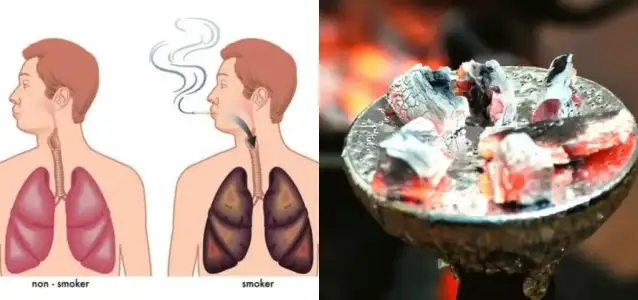Cancer and Other Risks of Hookah Smoking

The popularity of hookah smoking, in which a fruit-flavored tobacco artifact is inhaled through a glass pipe, raises concerns about its deleterious effects on cancer and other medical conditions. Hookah smoke contains many of the same carcinogens found in tobacco smoke. In fact, there are some indications that hookah smoke can be even more dangerous, depending on factors such as how much smoke is inhaled and how deeply it is inhaled.
Hookah smoking is especially popular among teens and young adults, who don’t realize that their multiple inhalations are as potentially dangerous as cigarette smoke.
According to a 2014 study, 18% of high school seniors claimed to have smoked hookah in the last 12 months. Other studies show that hookah smoking is around 30%, and multiple students are often unaware of the potential risk of illness. Studies among young adults found that up to 60% did not think hookah smoking had the dangers associated with smoking, and some did not think of it as “smoking.”
With the prestige of December 20, 2019, the new legal age limit for purchasing cigars or other tobacco products (including hookah tobacco) in the US is 21.
Toxins and Carcinogens
According to the Centers for Disease Control and Infection (CDC), hookah smoke is just as toxic as cigarette smoke: A 2015 review of studies examining potential toxins in hookah smoke found that the smoke contained 27 known or suspected carcinogens.
Many of these have been found to be in higher concentrations in hookah smoke than in cigarette smoke, including carbon monoxide (from the coal used to heat the water in the hookah pipe), which can contribute to heart disease; benzene; and highly molecularly charged polycyclic aromatic hydrocarbons (PAHs), whose levels are higher in hookah smoke than in cigarette smoke. Other toxins found in both cigarette and hookah smoke include arsenic, cobalt, chromium and lead.
More Amount of Smoke Inhaled
One reason hookah smoke is more toxic than cigarette smoke is because more smoke is inhaled. In a typical “session” (about an hour) of hookah smoking, 200 puffs are drawn versus the 20 puffs normally taken while smoking a single cigarette. This translates into a typical hookah session resulting in 90,000 milliliters (ml) of smoke inhaled compared to 500 to 600 ml of smoke inhaled with one cigarette.
Breath Depth
People tend to inhale hookah smoke more deeply than cigarette smoke. While this has not been proven to make sense, it may be helpful to look at changes in lung cancer rates after adding filters to cigarettes. Before cigarettes had filters, smoke was not inhaled so deeply and a type of lung cancer known as squamous cell carcinoma was more likely to cause lung cancer. This type of lung cancer is most commonly found in the large airways (bronchi) that enter the lungs, and due to this location it tends to be discovered at an earlier stage of the disease (because coughing, coughing, bleeding, wheezing and frequent infections due to airway obstruction).
With the addition of filters to cigarettes, lung adenocarcinoma has become more common. This type of lung cancer is mostly seen in the periphery of the lungs and because of this location it is mostly found in the advanced stages of the disease.
addiction
It is the nicotine in cigarettes that is addictive, and as in cigarette smoke, nicotine is present in hookah smoke. Despite advertising, hookah smoke also contains tar. It is the burning (with cigarette) or heating (with hookah) process that forms the tar. In fact, hookah smoking can result in greater exposure to tar as it lasts longer and requires a stronger drag.
Cancer Risk
Hookah smokers may be at risk for one-on-one cancers caused by smoking, including:
- Lung cancer: Many of the carcinogens that cause lung cancer are also found in hookah smoke, just like those found in cigarette smoke. According to a study conducted in India, hookah smokers are four times more likely to develop lung cancer than non-smokers.
- head and neck cancer
- Esophageal cancer
- Oral cancer: Tobacco irritates the tissues of the mouth and throat and causes inflammation that can lead to cancer, as seen in people who chew tobacco.
- Stomach cancer: Recent studies have shown a correlation between hookah smoking and gastric cancer and precancerous lesions in the stomachs of regular hookah users.
- Bladder cancer: Smoking causes 50% of bladder cancers in men in the United States.
- Pancreatic cancer: Studies have shown that hookah users have an increased risk of developing pancreatic cancer. Smoking hookah also increases the risk of gum disease, a valuable risk factor for pancreatic cancer.
Other Health Conditions Related to Hookah Smoking
Just as with smoking, there are many other health conditions associated with hookah smoking that go beyond cancer.
Hookah and Obesity
Although smoking is sometimes associated with weight loss, the opposite seems to be true for hookah smoking. A 2019 meta-analysis of studies examining the interrelationship between obesity and hookah smoking found that hookah smoking was associated with a higher risk of obesity, regardless of age or gender.
Exposure to Infections
While cigarettes are often smoked by one person alone, a hookah pipe is often shared by several, while “passing around” the pipe in a hookah lounge or residential event. Bacteria or viruses found in the mouths of hookah-smoker friends can be “shared,” including germs such as the oral herpes virus.
Other diseases and conditions that can result from hookah smoking are emphysema, chronic obstructive pulmonary disease (COPD), heart disease, osteoporosis, pregnancy complications, preterm birth, and infertility.
As a result, although hookah smoking is seemingly harmless and has the fruity taste of tobacco artifact, hookah habit can be just as dangerous to one’s health and that of loved ones, especially children and young adults, as smoking.
- On-Site Comments
















Comment